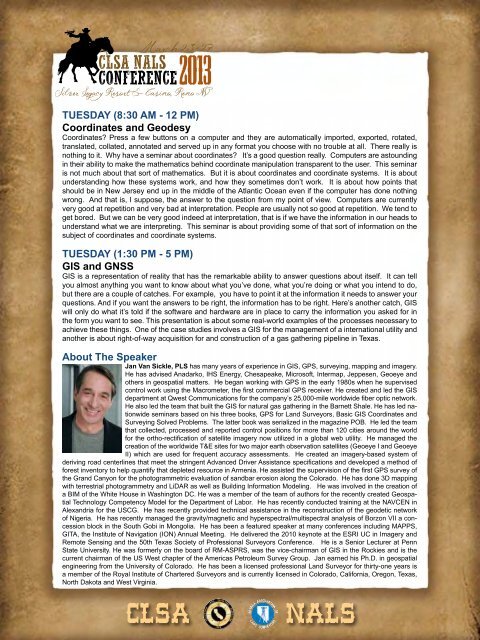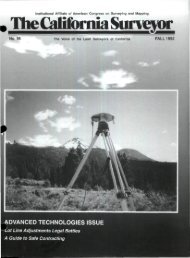CLSA NALS - California Land Surveyors Association
CLSA NALS - California Land Surveyors Association
CLSA NALS - California Land Surveyors Association
You also want an ePaper? Increase the reach of your titles
YUMPU automatically turns print PDFs into web optimized ePapers that Google loves.
TUESDAY (8:30 AM - 12 PM)<br />
Coordinates and Geodesy<br />
Coordinates? Press a few buttons on a computer and they are automatically imported, exported, rotated,<br />
translated, collated, annotated and served up in any format you choose with no trouble at all. There really is<br />
nothing to it. Why have a seminar about coordinates? It’s a good question really. Computers are astounding<br />
in their ability to make the mathematics behind coordinate manipulation transparent to the user. This seminar<br />
is not much about that sort of mathematics. But it is about coordinates and coordinate systems. It is about<br />
understanding how these systems work, and how they sometimes don’t work. It is about how points that<br />
should be in New Jersey end up in the middle of the Atlantic Ocean even if the computer has done nothing<br />
wrong. And that is, I suppose, the answer to the question from my point of view. Computers are currently<br />
very good at repetition and very bad at interpretation. People are usually not so good at repetition. We tend to<br />
get bored. But we can be very good indeed at interpretation, that is if we have the information in our heads to<br />
understand what we are interpreting. This seminar is about providing some of that sort of information on the<br />
subject of coordinates and coordinate systems.<br />
TUESDAY (1:30 PM - 5 PM)<br />
GIS and GNSS<br />
GIS is a representation of reality that has the remarkable ability to answer questions about itself. It can tell<br />
you almost anything you want to know about what you’ve done, what you’re doing or what you intend to do,<br />
but there are a couple of catches. For example, you have to point it at the information it needs to answer your<br />
questions. And if you want the answers to be right, the information has to be right. Here’s another catch, GIS<br />
will only do what it’s told if the software and hardware are in place to carry the information you asked for in<br />
the form you want to see. This presentation is about some real-world examples of the processes necessary to<br />
achieve these things. One of the case studies involves a GIS for the management of a international utility and<br />
another is about right-of-way acquisition for and construction of a gas gathering pipeline in Texas.<br />
About The Speaker<br />
Jan Van Sickle, PLS has many years of experience in GIS, GPS, surveying, mapping and imagery.<br />
He has advised Anadarko, IHS Energy, Chesapeake, Microsoft, Intermap, Jeppesen, Geoeye and<br />
others in geospatial matters. He began working with GPS in the early 1980s when he supervised<br />
control work using the Macrometer, the first commercial GPS receiver. He created and led the GIS<br />
department at Qwest Communications for the company’s 25,000-mile worldwide fiber optic network.<br />
He also led the team that built the GIS for natural gas gathering in the Barnett Shale. He has led nationwide<br />
seminars based on his three books, GPS for <strong>Land</strong> <strong>Surveyors</strong>, Basic GIS Coordinates and<br />
Surveying Solved Problems. The latter book was serialized in the magazine POB. He led the team<br />
that collected, processed and reported control positions for more than 120 cities around the world<br />
for the ortho-rectification of satellite imagery now utilized in a global web utility. He managed the<br />
creation of the worldwide T&E sites for two major earth observation satellites (Geoeye I and Geoeye<br />
II) which are used for frequent accuracy assessments. He created an imagery-based system of<br />
deriving road centerlines that meet the stringent Advanced Driver Assistance specifications and developed a method of<br />
forest inventory to help quantify that depleted resource in Armenia. He assisted the supervision of the first GPS survey of<br />
the Grand Canyon for the photogrammetric evaluation of sandbar erosion along the Colorado. He has done 3D mapping<br />
with terrestrial photogrammetry and LiDAR as well as Building Information Modeling. He was involved in the creation of<br />
a BIM of the White House in Washington DC. He was a member of the team of authors for the recently created Geospatial<br />
Technology Competency Model for the Department of Labor. He has recently conducted training at the NAVCEN in<br />
Alexandria for the USCG. He has recently provided technical assistance in the reconstruction of the geodetic network<br />
of Nigeria. He has recently managed the gravity/magnetic and hyperspectral/multispectral analysis of Borzon VII a concession<br />
block in the South Gobi in Mongolia. He has been a featured speaker at many conferences including MAPPS,<br />
GITA, the Institute of Navigation (ION) Annual Meeting. He delivered the 2010 keynote at the ESRI UC in Imagery and<br />
Remote Sensing and the 50th Texas Society of Professional <strong>Surveyors</strong> Conference. He is a Senior Lecturer at Penn<br />
State University. He was formerly on the board of RM-ASPRS, was the vice-chairman of GIS in the Rockies and is the<br />
current chairman of the US West chapter of the Americas Petroleum Survey Group. Jan earned his Ph.D. in geospatial<br />
engineering from the University of Colorado. He has been a licensed professional <strong>Land</strong> Surveyor for thirty-one years is<br />
a member of the Royal Institute of Chartered <strong>Surveyors</strong> and is currently licensed in Colorado, <strong>California</strong>, Oregon, Texas,<br />
North Dakota and West Virginia.<br />
<strong>CLSA</strong><br />
<strong>NALS</strong>

















